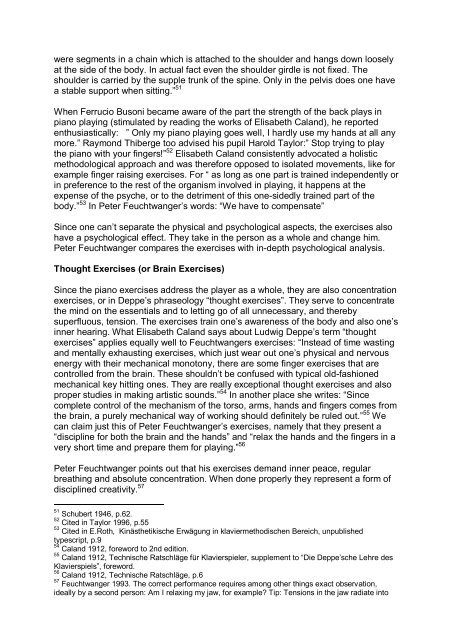Zen in the art of playing the piano - Peter Feuchtwanger
Zen in the art of playing the piano - Peter Feuchtwanger
Zen in the art of playing the piano - Peter Feuchtwanger
Create successful ePaper yourself
Turn your PDF publications into a flip-book with our unique Google optimized e-Paper software.
were segments <strong>in</strong> a cha<strong>in</strong> which is attached to <strong>the</strong> shoulder and hangs down loosely<br />
at <strong>the</strong> side <strong>of</strong> <strong>the</strong> body. In actual fact even <strong>the</strong> shoulder girdle is not fixed. The<br />
shoulder is carried by <strong>the</strong> supple trunk <strong>of</strong> <strong>the</strong> sp<strong>in</strong>e. Only <strong>in</strong> <strong>the</strong> pelvis does one have<br />
a stable support when sitt<strong>in</strong>g. 51<br />
When Ferrucio Busoni became aware <strong>of</strong> <strong>the</strong> p<strong>art</strong> <strong>the</strong> strength <strong>of</strong> <strong>the</strong> back plays <strong>in</strong><br />
<strong>piano</strong> play<strong>in</strong>g (stimulated by read<strong>in</strong>g <strong>the</strong> works <strong>of</strong> Elisabeth Caland), he reported<br />
enthusiastically: Only my <strong>piano</strong> play<strong>in</strong>g goes well, I hardly use my hands at all any<br />
more.Raymond Thiberge too advised his pupil Harold Taylor:Stop try<strong>in</strong>g to play<br />
<strong>the</strong> <strong>piano</strong> with your f<strong>in</strong>gers! 52 Elisabeth Caland consistently advocated a holistic<br />
methodological approach and was <strong>the</strong>refore opposed to isolated movements, like for<br />
example f<strong>in</strong>ger rais<strong>in</strong>g exercises. For as long as one p<strong>art</strong> is tra<strong>in</strong>ed <strong>in</strong>dependently or<br />
<strong>in</strong> preference to <strong>the</strong> rest <strong>of</strong> <strong>the</strong> organism <strong>in</strong>volved <strong>in</strong> play<strong>in</strong>g, it happens at <strong>the</strong><br />
expense <strong>of</strong> <strong>the</strong> psyche, or to <strong>the</strong> detriment <strong>of</strong> this one-sidedly tra<strong>in</strong>ed p<strong>art</strong> <strong>of</strong> <strong>the</strong><br />
body. 53 In <strong>Peter</strong> <strong>Feuchtwanger</strong>s words: We have to compensate<br />
S<strong>in</strong>ce one cant separate <strong>the</strong> physical and psychological aspects, <strong>the</strong> exercises also<br />
have a psychological effect. They take <strong>in</strong> <strong>the</strong> person as a whole and change him.<br />
<strong>Peter</strong> <strong>Feuchtwanger</strong> compares <strong>the</strong> exercises with <strong>in</strong>-depth psychological analysis.<br />
Thought Exercises (or Bra<strong>in</strong> Exercises)<br />
S<strong>in</strong>ce <strong>the</strong> <strong>piano</strong> exercises address <strong>the</strong> player as a whole, <strong>the</strong>y are also concentration<br />
exercises, or <strong>in</strong> Deppes phraseology thought exercises. They serve to concentrate<br />
<strong>the</strong> m<strong>in</strong>d on <strong>the</strong> essentials and to lett<strong>in</strong>g go <strong>of</strong> all unnecessary, and <strong>the</strong>reby<br />
superfluous, tension. The exercises tra<strong>in</strong> ones awareness <strong>of</strong> <strong>the</strong> body and also ones<br />
<strong>in</strong>ner hear<strong>in</strong>g. What Elisabeth Caland says about Ludwig Deppes term thought<br />
exercisesapplies equally well to <strong>Feuchtwanger</strong>s exercises: Instead <strong>of</strong> time wast<strong>in</strong>g<br />
and mentally exhaust<strong>in</strong>g exercises, which just wear out ones physical and nervous<br />
energy with <strong>the</strong>ir mechanical monotony, <strong>the</strong>re are some f<strong>in</strong>ger exercises that are<br />
controlled from <strong>the</strong> bra<strong>in</strong>. These shouldnt be confused with typical old-fashioned<br />
mechanical key hitt<strong>in</strong>g ones. They are really exceptional thought exercises and also<br />
proper studies <strong>in</strong> mak<strong>in</strong>g <strong>art</strong>istic sounds. 54 In ano<strong>the</strong>r place she writes: S<strong>in</strong>ce<br />
complete control <strong>of</strong> <strong>the</strong> mechanism <strong>of</strong> <strong>the</strong> torso, arms, hands and f<strong>in</strong>gers comes from<br />
<strong>the</strong> bra<strong>in</strong>, a purely mechanical way <strong>of</strong> work<strong>in</strong>g should def<strong>in</strong>itely be ruled out. 55 We<br />
can claim just this <strong>of</strong> <strong>Peter</strong> <strong>Feuchtwanger</strong>s exercises, namely that <strong>the</strong>y present a<br />
discipl<strong>in</strong>e for both <strong>the</strong> bra<strong>in</strong> and <strong>the</strong> handsand relax <strong>the</strong> hands and <strong>the</strong> f<strong>in</strong>gers <strong>in</strong> a<br />
very short time and prepare <strong>the</strong>m for play<strong>in</strong>g. 56<br />
<strong>Peter</strong> <strong>Feuchtwanger</strong> po<strong>in</strong>ts out that his exercises demand <strong>in</strong>ner peace, regular<br />
breath<strong>in</strong>g and absolute concentration. When done properly <strong>the</strong>y represent a form <strong>of</strong><br />
discipl<strong>in</strong>ed creativity. 57<br />
51<br />
Schubert 1946, p.62.<br />
52<br />
Cited <strong>in</strong> Taylor 1996, p.55<br />
53<br />
Cited <strong>in</strong> E.Roth, K<strong>in</strong>äs<strong>the</strong>tikische Erwägung <strong>in</strong> klaviermethodischen Bereich, unpublished<br />
typescript, p.9<br />
54<br />
Caland 1912, foreword to 2nd edition.<br />
55<br />
Caland 1912, Technische Ratschläge für Klavierspieler, supplement to Die Deppesche Lehre des<br />
Klavierspiels, foreword.<br />
56<br />
Caland 1912, Technische Ratschläge, p.6<br />
57<br />
<strong>Feuchtwanger</strong> 1993. The correct performance requires among o<strong>the</strong>r th<strong>in</strong>gs exact observation,<br />
ideally by a second person: Am I relax<strong>in</strong>g my jaw, for example? Tip: Tensions <strong>in</strong> <strong>the</strong> jaw radiate <strong>in</strong>to



